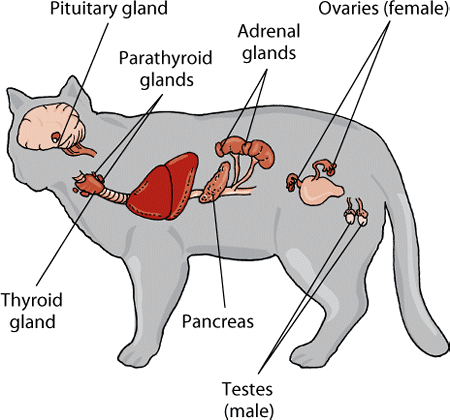mammary tumors in cats merck
Mammary tumors in cats are most often seen in older average age 11 years nonspayed females. Learn about the veterinary topic of Mammary Breast Tumors in Cats.

Download Pdf The Merck Veterinary Manual Free Epub Mobi Ebooks Veterinary Merck Hardcover Book
Hyperplasia occurs within 12 wk after estrus or 26 wk after progestin treatment.

. A mammary tumor is a neoplasm originating in the mammary gland. Mixed mammary tumors and sarcomas are less commonly diagnosed than carcinomas. Cancer in general afflicts an estimated 30 percent to 40 percent of all cats and one-third or so of these malignancies involve the mammary glands.
By spaying a cat at 6 months of age or. Mammary gland tumors are most common in middle-aged and older female cats but they can occur in younger female cats as well as male cats. They are more common in females than males and are also more common in un-spayed entire cats.
Treatment Options for Cats with Mammary Cancer. In cats the vast majority of mammary tumors are malignant. The cause of mammary tumors is unknown however hormones play an important role in their development.
Cat mammary gland tumors are formed by an abnormal mass of cells in the mammary breast glands. Approximately 90 of mammary tumors in cats are malignant cancerous. Mammary tumors develop because of spikes in female hormone estrogens that take place during a cats heat cycle.
Approximately 90 of mammary tumors are malignant in cats and cats have fewer complex and mixed tumors than dogs. Mammary tumors can be benign non-cancerous or malignant cancerous. Mammary tumors in cats merck.
Mammary tumor in cats merck. These tumors are a huge problem for cats. A palpable mass underneath the skin of the abdomen is the most common findings in dogs and cats with mammary tumors Figure 1.
There are several different types of. Mammary tumors in cats are most common in older average 11 years intact females. Almost 90 of feline mammary tumors are malignant meaning they have the potential to spread to other portions of the body.
They can be benign noncancerous or malignant cancerous. More than one tumor may be. The average age of affected cats is 10-11 years of age.
Surgery is the most common form of treatment for mammary cancer in cats. Benign tumors of the feline mammary gland. Approximately 90 of mammary tumors in cats are malignant cancerous.
Feline mammary tumors aka cat breast cancer are tumors of one or more of the mammary glands. A mammary tumor is usually suspected on detection of a mass during physical examination in the caudal abdominal and cranial thoracic mammary glands in dogs and cats respectively. The diagnosis is confirmed by histopathology and is important for.
It is a common finding in older female dogs and cats that are not spayed but they are found in other animals as well. Mammary tumors in cats also known as breast cancer in cats occur when normal cells in the mammary gland transform into tumor cells that can multiply and invade nearby or distant tissues by hematogenous or lymphatic routes. They are prone to spread metastasize to the lungs and lymph nodes.
A radical mastectomy or removal of all mammary glands on one side and some lymph nodes is usually recommended as there is a high recurrence of this type of cancer. Other forms of breast and mammary cancer in a cat include adenomas duct papillomas and sarcomas. Mammary cancer is the third most common cancer in cats.
Female 14 years old european mammary gland vegetant adenocarcinoma 3. According to the American College of Veterinary Surgeons 85 of them are cancerous ie. The mammary glands in dogs and cats are associated with their nipples and extend from the underside of the chest to the groin on both sides of the midline.
Mast cell tumors are a kind of tumor named for the type of skin cell from which they grow. These two forms of the disease have different diagnostics treatments management and prognosis. Tumors originating in these glands account for the third most common type of feline cancer after lymphoma and skin cancer.
Cats spayed before 6 months or 12 months of age have a 91 or an 86 reduction respectively in the risk of mammary carcinoma development compared to intact cats. Most feline mammary tumors are adenocarcinomas with tubular or papillary types more common than solid or mucoid types. The tremendously enlarged glands may appear erythematous and some of the skin may be necrotic.
There are many differences. Female 13 years old persian peritoneal cavity fluid Tumors of the trachea are particularly rare. Cats spayed before 6 months or 12 months of age have a 91 or an 86 reduction respectively in the risk of mammary carcinoma development compared to intact cats.
Histologic grading of these tumors is achieved using the Elston and Ellis system originally developed for human breast cancer. It is more common to have the tumors in the first pair of glands the cranial glands or the last pair the caudal glands. Therefore objectives of this study were 1 to evaluate the Elston and Ellis grading system for feline mammary carcinoma in a.
In contrast over 85 of mammary tumors in cats are malignant and most of these have. Occurring more than 95 percent of the time in females it is the most frequently diagnosed type of feline cancer. This type of cancer is actually the third most common in cats preceded by lymphoma and skin tumors.
Only 15 are benign What causes mammary tumors in cats. Parity does not affect feline mammary carcinoma development. Females as well as males can develop this form of cancer.
There are also generalized blood cell splenic and digestive tract forms of mast cell sarcoma. Tumors of the nose and sinuses are relatively uncommon in cats as compared to dogs. When it appears in cats it can be fatal even if treated with surgery radiation and chemotherapy.
Several reports have documented a strong association between the use of contraceptives and the development of benign or malignant mammary masses in cats. Sarcomas mucinous carcinomas duct papillomas adenosquamous carcinomas and. A mammary tumor develops as a result of abnormal replication of the cells that make up the breast tissue.
Mast cell tumors are the second most common skin tumor in cats. In cats however classification using this method has variable prognostic value. They are prone to spread metastasize to the lungs and lymph nodes.
Mammary cancer is usually a malignant adenocarcinoma that appears in one or more of a cats breasts. The most common sites of spread are regional lymph nodes and the lungs. However other signs and symptoms include discharge from a mammary gland ulceration of the skin over a gland painful swollen breasts Figure 2 loss of appetite weight loss and generalized weakness.
Feline mammary hypertrophy is considered to be a hormone-dependent dysplastic change in the mammary gland. Find specific details on this topic and related topics from the MSD Vet Manual. Your vet will send off part or all of the mass es for.
Approximately 85 of feline mammary tumors are malignant and are histologically classified as adenocarcinomas.

Bone Tumors In Dogs And Cats Musculoskeletal System Msd Veterinary Manual

Introduction To Hormonal Disorders Of Cats Cat Owners Merck Veterinary Manual

Download Pdf The Merck Veterinary Manual Free Epub Mobi Ebooks Veterinary Merck Hardcover Book

Download Pdf The Merck Veterinary Manual Free Epub Mobi Ebooks Veterinary Merck Hardcover Book

Feline Mammary Hyperplasia Animal Health Topics School Of Veterinary Medicine

Spay Tacular Party All About Animals Rescue Michigan

Spay Tacular Party All About Animals Rescue Michigan

Subcutaneous Hard Nodules In Cats

Tumors Of The Skin In Cats Cat Owners Merck Veterinary Manual

Spay Tacular 2020 All About Animals Rescue Michigan

Feline Mammary Gland Adenocarcinoma Avim O

Vetgrad 10 Minute Top Up The Website For Vets

Cat Pregnancy And Birth Signs Cat Pregnancy Length And More Petmd

Pathological And Immunohistochemical Microscopy Of Natural Cases Of Canine And Feline Neoplastic Mammary Lesions Microscopy And Microanalysis Cambridge Core

Tumors Of The Skin In Cats Cat Owners Merck Veterinary Manual

Mammary Tumors Vis Medicatrix Naturae Veterinary Clinic Facebook

Mammary Hypertrophy In Cats Reproductive System Merck Veterinary Manual

